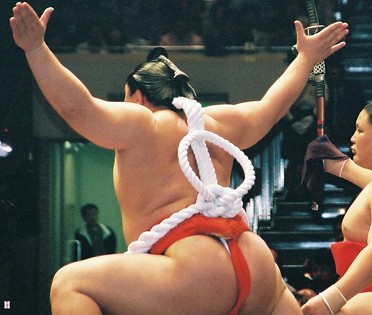| Nagoya Nears Eric Blair |


 |
| Rikishi of Old Joe Kuroda |

 |
| Heya Peek Barbara Ann Klein |


 |
| SFM Interview Mark Buckton |

 |
| Sumo 101 Barbara Ann Klein |
 |
| Photo Bonanza See the Natsu |
 |
| Natsu Basho Summary Lon Howard |

 |
| Lower Division Rikishi Mikko Mattila |

 |
| Nagoya Ones to Watch Mark Buckton |
 |
| Kimarite Focus Mikko Mattila |

 |
| Amateur Angles Howard Gilbert |

 |
| Sumo Game Bruce Rae |
 |
| Sumo in Print Barbara Ann Klein |
 |
| Kokugi Connections Todd Lambert |

 |
| Fan Debate Facilitator – Lon Howard |

 |
| SFM Cartoons Benny Loh & Stephen Thompson |
| Let’s Hear From You What was it that |


 |
| Readers’ Letters |
 |
Sumo Quiz
The Quizmaster
Answer the Qs and win yourself next basho’s banzuke.
First, a little history – the tsuna replicates the sacred ropes, or, shimenewa, which are situated to indicate a sacred Shinto place. It is almost always hung horizontally, and you will find it in shrines, around sacred trees said to embody kami (gods), and hanging from torii – the gates indicating a sacred place ahead and found on the approach to
Back to the process – the tsuna cloth (subsequent to the straw construction) used to be linen or hemp, but now seems to be a fine woven cotton. The lengths are a good 460 cm.each – about
colored wire. The wire used today did not appear to be copper, as it had been in the past. After a portion of the cloth was wrapped around the teppo, the lowest ranked rikishi had the chore of keeping one end of the material taut while the other rikishi were aided and spurred on by oyakata from Takasago and Hakkaku, Jinmaku from the latter.
The thickest part was braided first and was “padded” with
Next

